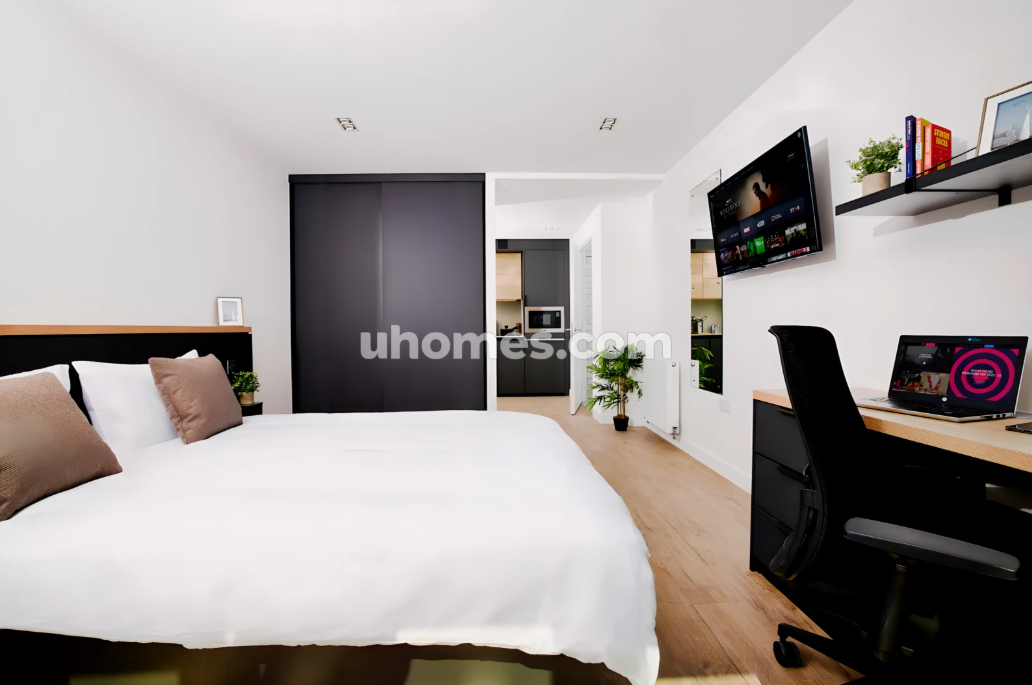Coed dorms are often discussed among students looking for accommodation nowadays, especially those who have moved to a new place or have been accepted into university. If you’ve heard about it but still have questions like: “What is coed housing?” or “What does it entail?” This blog can comprehensively address your inquiries. By introducing coed dorms’ meaning, structure, pros & cons, and how they compare to single-sex dorms, we’ll help you to figure out if a coed dorm is suitable for you and to simplify your search for the perfect student home.
What Is a Coed Dorm?
Many students encounter the term “coed dorm” when exploring campus living. Let’s start by clearly explaining the definition and common layouts of coed dormitories, which provides a foundation for your decision.
Coed Dorms Meaning
So, what does “coed dorms” mean? Simply put, it refers to a student residence where individuals of different genders live on the same floor or in the same building, some schools even allow co-ed rooms. This setup aims to foster a more integrated and modern community atmosphere. Coed hall, in practice, embodies the principle of shared common spaces and a diverse social environment, which is a defining feature of many coed residence halls today.
How Is It Structured?
It is reported that about 90% of schools in the USA are offering some form of co-ed housing. The structure of coed dormitories can vary across colleges, common configurations include:
- By Floor: This is a traditional layout where separate floors are designated for different genders. For example, one floor might house female students, while the next floor houses male students. Common areas like laundries or lounges might be shared by all.
- By Suite or Apartment: In this modern and popular setup, a small group of students shares a suite-style unit with a common living area and kitchen. The individual bedrooms within the suite are typically single-gender, but the suite itself is mixed-gender. This is a very common structure in newer student accommodation.
- By Wing or Section: A single floor might be divided into separate wings for different genders, sharing a central common space.
- Gender-Neutral/Gender-Inclusive Housing: An evolving option within some coed residence halls allows students to share a suite or apartment regardless of gender, focusing on mutual compatibility and comfort.
- Bathroom arrangements: This remains a top concern for students. The configuration varies across different coed residence halls: some feature communal bathrooms shared by the entire floor, while others provide private bathrooms within a suite to be shared among roommates.
Life in Coed Dorms: Benefits & Drawbacks
Attitudes toward coed halls are mixed. Some favor the increased social opportunities, while others express concerns about safety and distractions. Weighing them fairly foster realistic understandings.
Benefits of Coed Dormitories

A part of students claim living in a coed residence halls offer several benefits that may enrich university life. Below are the most common advantages:
- Diverse Social Environment: This is the most notable perk. Coed residence halls allow you to meet and interact with people of different genders, personalities, and cultural backgrounds. This creates a more balanced and realistic social environment, which is similar to what you encounter in workplaces and adult life and can help you better deal with various interpersonal relationships.
- Broader Perspective: Living alongside people of different genders is a key methods to break down gender stereotypes and broaden your horizon. As this can encourage mutual respect, build interpersonal communication skills, and make you more empathetic.
- Enhanced Sense of Community: Many students find that coed dormitories feel more like a balanced, vibrant community compared to single-sex dorms, with a wider variety of social activities and interactions. This expands your social network and leads to more natural friendships with the opposite sex, rather than a forced relationship.
- Inclusivity & Pluralism: Coed halls can offer a more inclusive and plural living situation, especially for certain minority groups, who can receive more understanding instead of bias. The flexible and less gender-segregated environment often provides a greater sense of belonging and reduces the pressure to conform to a specific gender-based housing assignment.
Drawbacks of Coed Halls
However, a lot of students contend that the disadvantages of coed dorms outweigh its benefits. It’s also essential to consider the potential downsides of a coed hall:
- Sexual harassment: The boundaries of gender seem ambiguous in mixed-gender environments under certain circumstances, thus it is more likely to occur harassment or inappropriate behavior, which is offensive. Students should be more aware of ensuring other residents feel respected.
- Distractions: The dynamic and lively scene can distract students from academic focus. When living in coed residence halls, students lacking of self-discipline are more inclined to indulge in gatherings, dates, or events, while ignoring a healthy work-life balance. This is detrimental to students’ mental and physical state.
- Discomfort: For some students, particularly those from conservative cultural or religious backgrounds, sharing living areas like bathrooms with the opposite gender can be intrusive and awkward. They have to be more mindful of their attire, which leads to ongoing inconvenience and stress.
The issue of safety and comfort often reveals a split opinion, much like two sides of the same coin: Some students report feeling safer with a mixed-gender presence, likening the environment to a family-like setting with brothers and sisters. Conversely, others might not feel at ease sharing living spaces with the opposite gender. This largely depends on the culture, religion, and personality.
Overall, living in a coed dorm presents a unique set of advantages and challenges. It is a dynamic environment that promotes social growth and inclusivity but also demands maturity, clear communication, and respect for boundaries. The experience is highly individual, and what works for one student may not suit another, so the next section will compare traditional single-sex dorms to set the stage for a wise decision.
Coed Dormitories vs Single-Sex Dorms: Differences

Choosing between coed halls and single-sex housing represents more than just a lifestyle preference, but a decision that can significantly shape your university experience across multiple dimensions. Understanding these key differences will help you select the environment where you’re most likely to thrive academically and socially.
- Social environment
Coed dormitories typically encourage more interaction between male and female students. In contrast, single-sex dorms create a more uniform environment with residents who share similar daily routines and comportment.
- Privacy levels
Despite most colleges offering coed halls, many students still choose single-sex dorms for privacy reasons, such as being unaccustomed to sharing bathrooms with the opposite gender.
- Noise and lifestyle
Because coed residence halls often house a large and diverse group of students, they are usually livelier than single-sex dorms. This is especially true in first-year residence buildings.
- Cultural and personal comfort
Students from cultural or religious backgrounds that value gender separation may feel more comfortable in single-sex housing. Meanwhile, students who want a modern, mixed-gender environment often prefer coed dorms.
The table below provides a clear comparison:
| Feature | Coed Dorms | Single-Sex Dorms |
|---|---|---|
| Social Dynamic | Diverse, mixed-gender, mirrors a broader society. | More focused, often uniform bonds. |
| Social Opportunities | Wider and more varied. Can feel more natural for some. | May feel limited or insular to some students. |
| Privacy | Requires more conscious effort | Often perceived as more private and relaxed. |
| Atmosphere | Typically more vibrant, energetic, and bustling. | Often quieter, more focused, and can feel more supportive. |
| Cultural Fit | For open, flexible environments | For those needing gender boundaries |
| Ideal For | Outgoing students, those comfortable with diversity, students seeking a modern campus experience. | Students who value privacy, specific cultural/religious practices, or a focused academic environment. |
Choose Coed Residence Halls: What to Consider?
After an in-depth understanding of the pros and cons of both coed dorms and traditional single-sex dorms. It’s time to make a choice. Each dorm type has its advantages and disadvantages, thus suiting different people. Making an informed choice supports a positive experience.
Factors to Consider Before Decision
If you’re leaning towards the vibrant life of a coed hall, take a moment for a thoughtful self-assessment. Ask yourself these questions:
- Your comfort level with mixed-gender spaces
This is the most fundamental consideration. Consider whether you feel at ease sharing private space with students of different genders. Understanding your own boundaries is the first step in determining if coed dorms are suitable.
- Privacy issue and lifestyle
Privacy in coed dormitories extends to your entire living experience. The dynamic nature of coed halls means common areas are often social hubs. If you need a quiet retreat to recharge after a long day, you must assess whether the bustling environment and blurred boundaries of a coed dorm aligns with your needs for personal space.
- Noise tolerance
A coed hall tends to have a lively atmosphere, especially in universities with many first-year students. If you value quiet study time, check whether your university provides quiet floors or mixed-gender but academically focused halls.
- Cultural or religious considerations
Some cultures and religions have norms regarding interactions between genders. It’s essential to choose a living situation that allows you to comfortably adhere to your values and practices without feeling pressured or uncomfortable.
- Interest in social engagement
If you prefer vibrant social environments, coed residence halls are great. They often organize mixed-gender events and communal activities for peers. If you prefer a smaller, tighter-knit circle of friends and a calmer environment, the highly social nature of a coed hall might make you feel overwhelming.
In conclusion, there’s no universally “better” option. Your decision should be based on your personality and goals.
Other Accommodation Options
If you think living in coed dorms isn’t for you, there are many other living options that can provide better comfort and privacy.

First, you can choose to live in a studio or a 1-bed apartment, which allows you to live alone with full privacy: your own bathroom, your own kitchen, a larger space, complete control, and total independence.
Second, ensuite rooms are a middle-ground option. They offer a private bathroom with a shared kitchen, giving a balance between privacy and community.
Otherwise, you can choose to live in shared apartments with selected gender roommates. This is where uhomes.com can be your most powerful tool. If you’re looking for a single-gender shared apartment or ensuite room, our professional rental consultants will assist you in finding the perfect property that meets your needs. We don’t just accommodate gender preferences, but also perfectly resolve all your concerns about budget, commuting convenience, and more. Our quality properties span over 500 cities worldwide, with options available near more than 2,000 universities. Beyond our extensive coverage, uhomes.com offers exceptional advantages:
- 1-on-1 property manager will help you through the entire process
- Enjoy bills-inclusive pricing and special offers including highest cashback, vouchers, group booking discounts, and seasonal promotions
- Access modern facilities like gyms, cinema rooms, games areas, laundry rooms, and rooftop terraces in the accommodations
Whether you’re looking for a private studio in Sydney, a single-sex shared apartment in Toronto, a modern coed dorm in Los Angeles, or just a common ensuite in London, uhomes.com has you covered. You can search by city, university, budget, and room type to instantly see your best options.
What Colleges Have Coed Dorms?
Extensive universities now offer coed residence halls, especially those in English-speaking countries like the US and Canada. Below is a list of popular institutions known for flexible and modern coed housing:
- United States:
University of California, Los Angeles (UCLA)
California Institute of Technology (Caltech)
Stanford University
Pennsylvania State University
Brown University
- Canada:
University of Toronto
University of British Columbia
McGill University
The best way to confirm is to check the specific housing website of the university. Alternatively, you can use uhomes.com to browse available student apartments near your chosen university, our listings clearly state the property type and often specify the housing arrangements.

Coed Dorms: Conclusion
So, are coed dorms the right choice for you? As we’ve explored, there is no one-size-fits-all answer. Coed dormitories offer a great opportunity for social growth, diversity, and a vibrant community experience. However, living with the opposite gender may result in distraction, misconception or troublesome situation. Hence, students should foster a level of maturity and consideration with a mixed-gender environment.
When deciding on a coed dorm, your decision should hinge on several personal factors, including your personality, lifestyle habit, cultural background, and most importantly, your acceptance of privacy and other sensitive issues. If you are an adaptable, outgoing individual who values a dynamic social scene and is prepared to navigate the complexities of a mixed-gender living space, then a coed dorm could be a rewarding chapter of your university life. Conversely, if you prioritize maximum privacy, a quieter atmosphere, or have specific personal or cultural preferences, a single-sex dorm or private studio might align better with your needs.
In a word, weigh the benefits against the drawbacks fairly, and consider all the alternative housing options available. As your student accommodation might not just be a place to sleep; it’s a key part of your university journey.
FAQs about Coed Dorms
What does co ed mean?
“Coed” is a shortened term for “co-educational.” In the context of student housing, it means that the residence hall or apartment accommodates both male and female students.
What colleges have coed dorms?
The vast majority of modern universities have colleges with coed dorms. This includes most major institutions in the UK, US, and Canada. Specific examples include:
University of California, Los Angeles (UCLA), California Institute of Technology (Caltech), Stanford University, Pennsylvania State University, and Brown University
What is coed housing?
Coed housing is a style of student accommodation where students of different genders live in the same building, on the same floor, or in the same suite. Bedrooms are usually single-gendered, bathrooms and common areas might mostly be shared.
What are coed dorms like?
Coed dorms are dynamic, social, and diverse. You can expect a mix of people in common areas, a broader range of social activities, and a community that feels more representative of the real world. They require a bit more mindfulness about privacy and shared space etiquette.






